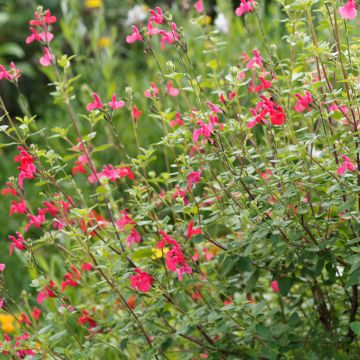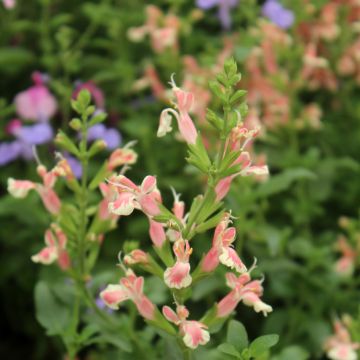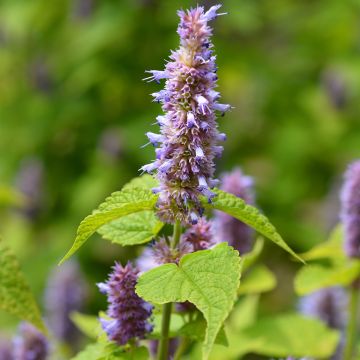

Salvia setulosa


Salvia setulosa
Salvia setulosa
Salvia setulosa
Special offer!
Receive a €20 voucher for any order over €90 (excluding delivery costs, credit notes, and plastic-free options)!
1- Add your favorite plants to your cart.
2- Once you have reached €90, confirm your order (you can even choose the delivery date!).
3- As soon as your order is shipped, you will receive an email containing your voucher code, valid for 3 months (90 days).
Your voucher is unique and can only be used once, for any order with a minimum value of €20, excluding delivery costs.
Can be combined with other current offers, non-divisible and non-refundable.
Home or relay delivery (depending on size and destination)
Schedule delivery date,
and select date in basket
This plant carries a 12 months recovery warranty
More information
We guarantee the quality of our plants for a full growing cycle, and will replace at our expense any plant that fails to recover under normal climatic and planting conditions.
Would this plant suit my garden?
Set up your Plantfit profile →
Description
Salvia setulosa, sometimes called bristly sage, is a wild sage native to Mexico. It is not very spectacular and is little known to gardeners. It is a slightly creeping plant, tender but well adapted to dry soils. It is recognised by its hairy, fairly dark green vegetation and its reasonably discreet blue summer flowering. Like other sages, it has melliferous flowers and aromatic leaves. Outside of Mediterranean gardens spared by severe frosts, it can be grown in a planter, which allows it to be stored away for the winter.
Salvia setulosa is native to Mexico, specifically the provinces of Mexico and Oaxaca, where it is found at an altitude of up to 1830 m. Like all other sages, it belongs to the large family of Lamiaceae or Labiatae. It is a woody-based herbaceous perennial species which has a more or less creeping habit. Fast-growing, the plant reaches about 60 cm in height with a minimum spread of 40 cm. Its foliage is theoretically evergreen in winter; its leafy stems are covered with short hairs. Its leaves measure up to 6 cm long and 4 cm wide; they are deltoid in shape, with crenate margins and a relatively dark green colour on the upper side. This sage blooms between June and August in a Mediterranean climate. At the end of the stems, short spikes form with whorls or crowns of 3 small bilabiate flowers of a relatively light blue colour. Butterflies and bees highly prize Melliferous and nectariferous.
The hardiness of this bristly sage does not exceed -6 °C at its coldest in well-drained, sandy or rocky soil, dry in winter. It is a collectable sage that can be grown in full sun in a Mediterranean climate. Elsewhere, it can be grown in a pot to protect it from excessive moisture and severe frosts in winter. In border plantings or rock gardens, for example, it can be paired with thymes, oregano, santolines or even Erigeron karvinskianus.
With over 900 species of annuals, perennials, and bushes distributed all over our planet, except for very cold regions and tropical forests, the genus Salvia is the richest in the Lamiaceae family. The name Salvia, which dates back to Roman times, derives from the Latin salvus "healthy" in allusion to the medicinal properties of common sage.
Report an error about the product description
Flowering
Foliage
Plant habit
Botanical data
Salvia
setulosa
Lamiaceae
Central Africa
Other Salvia - Sage
View all →Planting and care
Plant Salvia setulosa in a very well-drained, light soil that does not retain moisture in winter. This plant tolerates drought well and withstands short frosts of around -6°C. If you plant it in a borderline hardiness zone, mulch the stump in winter. It does not appreciate clayey and wet soils in winter, which can harm its hardiness. You should plant it in a very sunny location. It is a modest and undemanding plant, less well-known because it is less spectacular than other species.
Planting period
Intended location
Care
This item has not been reviewed yet - be the first to leave a review about it.
Similar products
Haven't found what you were looking for?
Hardiness is the lowest winter temperature a plant can endure without suffering serious damage or even dying. However, hardiness is affected by location (a sheltered area, such as a patio), protection (winter cover) and soil type (hardiness is improved by well-drained soil).

Photo Sharing Terms & Conditions
In order to encourage gardeners to interact and share their experiences, Promesse de fleurs offers various media enabling content to be uploaded onto its Site - in particular via the ‘Photo sharing’ module.
The User agrees to refrain from:
- Posting any content that is illegal, prejudicial, insulting, racist, inciteful to hatred, revisionist, contrary to public decency, that infringes on privacy or on the privacy rights of third parties, in particular the publicity rights of persons and goods, intellectual property rights, or the right to privacy.
- Submitting content on behalf of a third party;
- Impersonate the identity of a third party and/or publish any personal information about a third party;
In general, the User undertakes to refrain from any unethical behaviour.
All Content (in particular text, comments, files, images, photos, videos, creative works, etc.), which may be subject to property or intellectual property rights, image or other private rights, shall remain the property of the User, subject to the limited rights granted by the terms of the licence granted by Promesse de fleurs as stated below. Users are at liberty to publish or not to publish such Content on the Site, notably via the ‘Photo Sharing’ facility, and accept that this Content shall be made public and freely accessible, notably on the Internet.
Users further acknowledge, undertake to have ,and guarantee that they hold all necessary rights and permissions to publish such material on the Site, in particular with regard to the legislation in force pertaining to any privacy, property, intellectual property, image, or contractual rights, or rights of any other nature. By publishing such Content on the Site, Users acknowledge accepting full liability as publishers of the Content within the meaning of the law, and grant Promesse de fleurs, free of charge, an inclusive, worldwide licence for the said Content for the entire duration of its publication, including all reproduction, representation, up/downloading, displaying, performing, transmission, and storage rights.
Users also grant permission for their name to be linked to the Content and accept that this link may not always be made available.
By engaging in posting material, Users consent to their Content becoming automatically accessible on the Internet, in particular on other sites and/or blogs and/or web pages of the Promesse de fleurs site, including in particular social pages and the Promesse de fleurs catalogue.
Users may secure the removal of entrusted content free of charge by issuing a simple request via our contact form.
The flowering period indicated on our website applies to countries and regions located in USDA zone 8 (France, the United Kingdom, Ireland, the Netherlands, etc.)
It will vary according to where you live:
- In zones 9 to 10 (Italy, Spain, Greece, etc.), flowering will occur about 2 to 4 weeks earlier.
- In zones 6 to 7 (Germany, Poland, Slovenia, and lower mountainous regions), flowering will be delayed by 2 to 3 weeks.
- In zone 5 (Central Europe, Scandinavia), blooming will be delayed by 3 to 5 weeks.
In temperate climates, pruning of spring-flowering shrubs (forsythia, spireas, etc.) should be done just after flowering.
Pruning of summer-flowering shrubs (Indian Lilac, Perovskia, etc.) can be done in winter or spring.
In cold regions as well as with frost-sensitive plants, avoid pruning too early when severe frosts may still occur.
The planting period indicated on our website applies to countries and regions located in USDA zone 8 (France, United Kingdom, Ireland, Netherlands).
It will vary according to where you live:
- In Mediterranean zones (Marseille, Madrid, Milan, etc.), autumn and winter are the best planting periods.
- In continental zones (Strasbourg, Munich, Vienna, etc.), delay planting by 2 to 3 weeks in spring and bring it forward by 2 to 4 weeks in autumn.
- In mountainous regions (the Alps, Pyrenees, Carpathians, etc.), it is best to plant in late spring (May-June) or late summer (August-September).
The harvesting period indicated on our website applies to countries and regions in USDA zone 8 (France, England, Ireland, the Netherlands).
In colder areas (Scandinavia, Poland, Austria...) fruit and vegetable harvests are likely to be delayed by 3-4 weeks.
In warmer areas (Italy, Spain, Greece, etc.), harvesting will probably take place earlier, depending on weather conditions.
The sowing periods indicated on our website apply to countries and regions within USDA Zone 8 (France, UK, Ireland, Netherlands).
In colder areas (Scandinavia, Poland, Austria...), delay any outdoor sowing by 3-4 weeks, or sow under glass.
In warmer climes (Italy, Spain, Greece, etc.), bring outdoor sowing forward by a few weeks.



















































